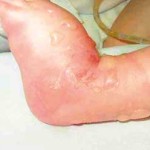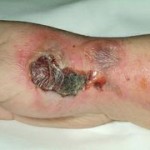I have had the opportunity to review quite a few cases that involved IV infiltration/extravasation and have been deposed in two of those cases. But can one assume that all IV infiltrations suggest negligence on the part of the nursing staff caring for the patient?
IV sites infiltrate every day through no fault of the nursing staff. Some of the causes of IV infiltration/extravasation that are not necessarily controlled by the nursing staff include high delivery rate of fluid, high pressure from the pump device, obstruction of blood flow through the catheter, and phlebitis. The signs and symptoms of infiltration/extravasation include: 1) infusion of fluid slows or stops, 2) skin around the IV site is cool to the touch, 3) skin is tight, 4) swelling, 5) absence of diluted blood return, and 6) pain. Complications from IV infiltration/extravasation include tissue damage, including necrosis, compartment syndrome, and reflex sympathetic dystrophy syndrome.
The nurse’s responsibility lies in the close monitoring of peripheral IV sites and recognizing signs and symptoms of infiltration/extravasation in a timely manner, infusing only fluids that are acceptable for peripheral IV sites, and using the correct size catheter. Detailed documentation of IV site assessments is imperative in the care of the patient. IV sites should be numbered and have the fluids/medications infusing listed. Check marks in a box saying the IV site was evaluated is not an acceptable or complete method to document assessments of IV sites. IV’s that are closely monitored for signs of infiltration/extravasation should not result in severe complications in the event that an infiltration/extravasation does occur. If an infiltration/extravasation does occur immediately stop the infusion of fluid/medication. If the IV was infusing medication attempt to aspirate the medication prior to discontinuing the IV catheter. Warm or cold compresses may then be applied to the site depending on the hospital policy.
Considerations for Picking the Correct Vascular Access Device
Extravasation of vasoactive substances (eg, dobutamine, dopamine, epinephrine, norepinephrine, and vasopressin) can result in ischemic necrosis because these substances reduce blood flow by causing severe constriction of smooth muscles around capillaries. In addition, solutions with high electrolyte concentrations (eg, calcium chloride 5.5% or sodium chloride 3% or 5%) can prolong the depolarization and contraction of pre- and postcapillary smooth muscle sphincters, which, in turn, prolongs exposure to injurious substances and leads to ischemia and tissue necrosis (Darcy Doellman, et al., 2009). Most institutions have policies regarding the need for central line access for the infusion of vasoactive medications except in an emergency situation.
Drugs with a pH below 5, including Vancomycin, should not be infused through a peripheral vein, according to current Infusion Nurses Society standards of practice. Occasionally, Vancomycin is prescribed until culture results are known. In these cases a central venous catheter may not be inserted until the diagnosis is confirmed, and a peripheral catheter is the only choice. To limit the potential for vein irritation and extravasation, the use of a small-gauge catheter, such as a 24-gauge, in the largest peripheral vein possible is necessary (Lynn Hadaway, 2004).
Works Cited
Darcy Doellman, B. R., Hadaway, Med, RN, BC, CRNI, L., Bowe-Geddes BS, RN, CRNI, L. A., Franklin, BSN, RN, MBA, CRNI, M., LeDonne, MD, J., Papke-O’Donnell, MSN, RN, CRNI, L., & Pettit, MSN, RNC, NNP, CNS, J. (2009, July/August). Infiltration and Extravasation: Update on Prevention and Management. Retrieved from Nursing Center.com: http://www.nursingcenter.com/lnc/static?pageid=1003404
Lynn Hadaway, R. C. (2004). Giving Vancomycin Safely. Nursing , 17.
Jane K. German
Thank you for sharing this article. I have worked on numerous cases regarding same for which many of these cases settled and might not have knowing this information.